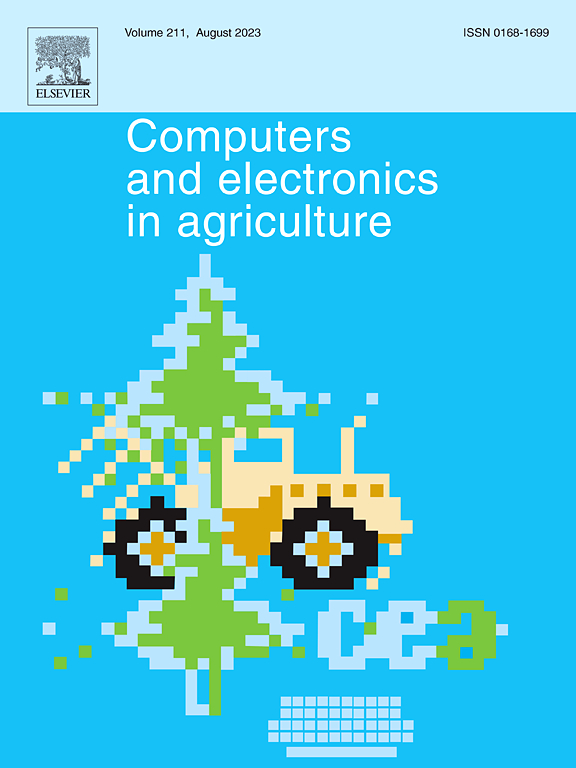High-throughput wheat seedling phenotyping via UAV-based semantic segmentation and ground sample distance driven pixel-to-area mapping
IF 8.9
1区 农林科学
Q1 AGRICULTURE, MULTIDISCIPLINARY
引用次数: 0
Abstract
Traditional methods for estimating wheat seedling area, such as manual grid sampling or ground-based sensors, suffer from low precision, labour intensity, and limited scalability under complex field conditions. To address these challenges, this study introduces a pixel-to-area phenotyping framework that integrates Wheat Seedling Former semantic segmentation with Ground Sample Distance (GSD)-based spatial conversion to achieve high-throughput quantification of wheat seedling coverage and growth vigour. The framework employs a three-step preprocessing pipeline, linear regression-based colour calibration, super-green (ExG) segmentation, and modified anisotropic diffusion filtering, to enhance image quality and suppress noise. The Wheat Seedling Former network incorporates a spatial-channel dual attention module to mitigate background interference and a cross-layer feature pyramid architecture to capture fine-scale morphological traits (e.g., leaf edges, tiller distribution). By aligning RGB and multispectral imagery via geometric correction (holography transformation) and spectral correction (soil-reflection suppression), the framework quantifies six phenotypic indices: seedling coverage area, canopy compactness, NDVI, NDRE, chlorophyll index, and foliage projection coverage. Applied to 160 field plots, the model achieved a Pearson correlation coefficient of 0.942 with ground-truth measurements, demonstrating high accuracy. GSD-based spatial conversion reduced scaling errors to < 3 %, enabling precise area estimation (±0.5 m2) even on uneven terrain. Phenotypic analysis stratified plots into three vigor classes: 35 high-performing (≥90 % canopy closure), 83 medium (60–90 %), and 42 low (<60 %), with high-performing genotypes showing 28 % higher drought tolerance. A software tool (Seedling Phenotype Extractor) automates image annotation, phenotypic calculations, and genotype ranking, reducing phenotyping time by 65 %. This pipeline bridges computational precision and field-scale breeding applications, offering a scalable tool for accelerating the discovery of stress-resilient wheat cultivars through rapid, non-destructive assessment of early-season canopy plasticity.
基于无人机语义分割和地面样本距离驱动的高通量小麦幼苗表型分析
传统的估算小麦幼苗面积的方法,如人工网格采样或地面传感器,存在精度低、劳动强度大、在复杂的田间条件下可扩展性有限等问题。为了解决这些问题,本研究引入了一个像素-面积表型框架,该框架将小麦幼苗前语义分割与基于地面样本距离(Ground Sample Distance, GSD)的空间转换相结合,实现小麦幼苗盖度和生长活力的高通量量化。该框架采用三步预处理管道,基于线性回归的颜色校准,超绿(ExG)分割和改进的各向异性扩散滤波,以提高图像质量并抑制噪声。小麦幼苗前网络结合了一个空间通道双注意模块来减轻背景干扰,以及一个跨层特征金字塔架构来捕捉精细尺度的形态特征(如叶片边缘、分蘖分布)。通过几何校正(全息变换)和光谱校正(土壤反射抑制)对RGB和多光谱图像进行比对,该框架量化了6个表型指标:幼苗覆盖面积、冠层密实度、NDVI、NDRE、叶绿素指数和叶片投影覆盖率。该模型应用于160个样地,与真实值的Pearson相关系数为0.942,具有较高的精度。基于gsd的空间转换将缩放误差降低到<;3%,即使在不平坦的地形上也能精确估计面积(±0.5 m2)。表型分析将地块分为3个活力等级:35个高性能(≥90%冠层闭合)、83个中等(60 - 90%)和42个低(< 60%),其中高性能基因型的耐旱性高出28%。一个软件工具(幼苗表型提取器)自动化图像注释、表型计算和基因型排序,将表型时间减少65%。该管道连接了计算精度和田间育种应用,提供了一个可扩展的工具,通过快速,非破坏性的早期冠层可塑性评估来加速发现抗应力小麦品种。
本文章由计算机程序翻译,如有差异,请以英文原文为准。
求助全文
约1分钟内获得全文
求助全文
来源期刊

Computers and Electronics in Agriculture
工程技术-计算机:跨学科应用
CiteScore
15.30
自引率
14.50%
发文量
800
审稿时长
62 days
期刊介绍:
Computers and Electronics in Agriculture provides international coverage of advancements in computer hardware, software, electronic instrumentation, and control systems applied to agricultural challenges. Encompassing agronomy, horticulture, forestry, aquaculture, and animal farming, the journal publishes original papers, reviews, and applications notes. It explores the use of computers and electronics in plant or animal agricultural production, covering topics like agricultural soils, water, pests, controlled environments, and waste. The scope extends to on-farm post-harvest operations and relevant technologies, including artificial intelligence, sensors, machine vision, robotics, networking, and simulation modeling. Its companion journal, Smart Agricultural Technology, continues the focus on smart applications in production agriculture.
 求助内容:
求助内容: 应助结果提醒方式:
应助结果提醒方式:


